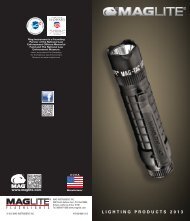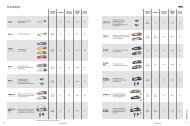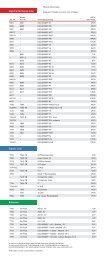2013 NITECORE Product Catalogue
2013 NITECORE Product Catalogue
2013 NITECORE Product Catalogue
You also want an ePaper? Increase the reach of your titles
YUMPU automatically turns print PDFs into web optimized ePapers that Google loves.
4 <strong>2013</strong> <strong>NITECORE</strong> <strong>Product</strong> <strong>Catalogue</strong> 5<br />
What is an LED?<br />
LED is an acronym for Light Emitting Diode – a special type of semiconductor that was<br />
initially used to replace standard lamps in early electronic equipment, later progressing<br />
to consumer electronics in the form of VCR and calculator displays. In the past decade,<br />
massive advances have been made in LED technology, with today’s high-power white tint<br />
LED’s commonly used in automotive/bicycle lighting, aviation, laptops and televisions, and<br />
even home lighting. LED technology is fast replacing older incandescent technologies (such<br />
as halogen and tungsten) due to its superior efficiency, durability and longevity, making it the<br />
ideal solution for the 21st century.<br />
Quick Activation<br />
An incandescent bulb generally<br />
takes about 100-300 milliseconds to<br />
illuminate once activated, while an<br />
LED needs only a few nanoseconds,<br />
giving it a significant advantage in<br />
highly demanding applications.<br />
1% light<br />
99% heat<br />
Regular lamp<br />
20% light<br />
80% heat<br />
LED<br />
The LED advantage…<br />
Energy savings<br />
LED's convert approximately 20% of their input power into light energy, compared to conventional<br />
incandescent bulbs which generally only convert about 2% of their input power into light. As a result,<br />
<strong>NITECORE</strong>’s<br />
Proprietary LED<br />
Technology…<br />
LED technology offers excellent energy savings over competing alternatives, making it a cost effective<br />
and environmentally-friendly solution for modern light-emitting devices.<br />
<strong>NITECORE</strong>’s highly efficient, ultra<br />
Longevity<br />
reliable proprietary LED drive circuit<br />
plays a crucial role in efficiently<br />
The principle behind conventional incandescent technology is based on electrons travelling through<br />
transferring battery power to<br />
a tungsten filament, causing the filament to generate temperatures of up to 2500 Celsius, with light<br />
the LED. As a result, all <strong>NITECORE</strong><br />
energy merely a byproduct of this process. Due to this inherently inefficient design, incandescent bulbs<br />
products have exceptional output<br />
rapidly deteriorate and burn out after about 1000 hours of use. LED’s, on the other hand, operate on<br />
and long runtimes in comparison<br />
an entirely different principle, and while they do require specialized components to achieve maximum<br />
to competing products. While the<br />
brightness, a working lifespan up to 50,000 hours is possible, with a gradual fading of brightness<br />
majority of LED-based flashlight/<br />
rather than instant burn-out.<br />
personal lighting products on<br />
Durability<br />
Due to the absence of a delicate filament and thin glass bulb, LEDs can withstand shock and vibration<br />
far beyond that tolerated by incandescent lamps making them ideal for rugged and demanding<br />
applications.<br />
the market today suffer from<br />
continuously declining output,<br />
<strong>NITECORE</strong> products are able to<br />
maintain constant high output until<br />
battery exhaustion.








